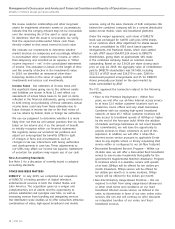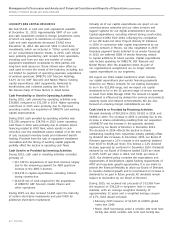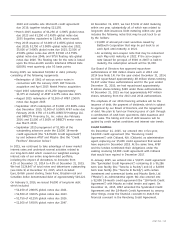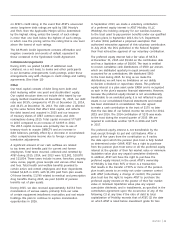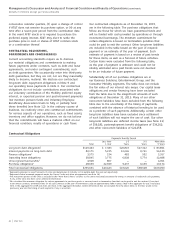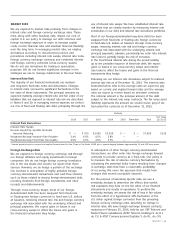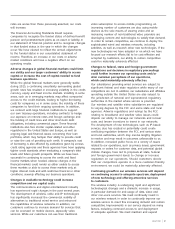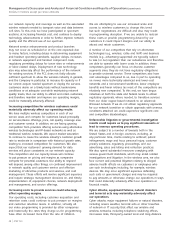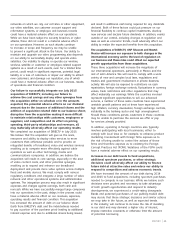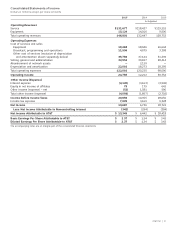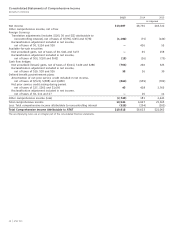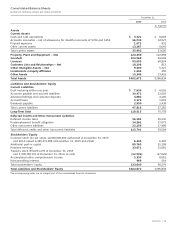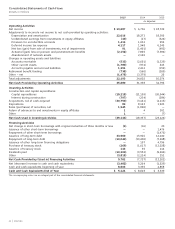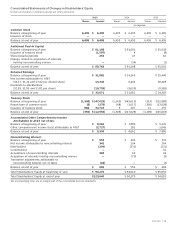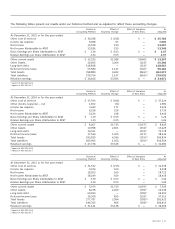AT&T Wireless 2015 Annual Report Download - page 40
Download and view the complete annual report
Please find page 40 of the 2015 AT&T Wireless annual report below. You can navigate through the pages in the report by either clicking on the pages listed below, or by using the keyword search tool below to find specific information within the annual report.
Management’s Discussion and Analysis of Financial Condition and Results of Operations (continued)
Dollars in millions except per share amounts
38
|
AT&T INC.
our network capacity and coverage as well as the associated
wireline network needed to transport voice and data between
cell sites. To this end, we have participated in spectrum
auctions, at increasing financial cost, and continue to deploy
technology advancements in order to further improve network
quality and the efficient use of our spectrum.
Network service enhancements and product launches
may not occur as scheduled or at the cost expected due
to many factors, including delays in determining equipment
and handset operating standards, supplier delays, increases
in network equipment and handset component costs,
regulatory permitting delays for tower sites or enhancements
or labor-related delays. Deployment of new technology
also may adversely affect the performance of the network
for existing services. If the FCC does not fairly allocate
sufficient spectrum to allow the wireless industry in general,
and the Company in particular, to increase its capacity or if
we cannot acquire needed spectrum or deploy the services
customers desire on a timely basis without burdensome
conditions or at adequate cost while maintaining network
quality levels, then our ability to attract and retain customers,
and therefore maintain and improve our operating margins,
could be materially adversely affected.
Increasing competition for wireless customers could
materially adversely affect our operating results.
We have multiple wireless competitors in each of our
service areas and compete for customers based principally
on service/device offerings, price, call quality, coverage area
and customer service. In addition, we are facing growing
competition from providers offering services using alternative
wireless technologies and IP-based networks as well as
traditional wireline networks. We expect market saturation
to continue to cause the wireless industry’s customer growth
rate to moderate in comparison with historical growth rates,
leading to increased competition for customers. We also
expect that our customers’ growing demand for data
services will place constraints on our network capacity.
This competition and our capacity issues will continue
to put pressure on pricing and margins as companies
compete for potential customers. Our ability to respond
will depend, among other things, on continued improvement
in network quality and customer service and effective
marketing of attractive products and services, and cost
management. These efforts will involve significant expenses
and require strategic management decisions on, and timely
implementation of, equipment choices, network deployment
and management, and service offerings.
Increasing costs to provide services could adversely
affect operating margins.
Our operating costs, including customer acquisition and
retention costs could continue to put pressure on margins
and customer retention levels. In addition, virtually all
our video programming is provided by other companies
and historically the rates they charge us for programming
have often increased more than the rate of inflation.
We are attempting to use our increased scale and
access to wireless customers to change this trend
but such negotiations are difficult and also may result
in programming disruption. If we are unable to restrain
these costs or provide programming desired by our
customers it could impact margins and our ability to
attract and retain customers.
A number of our competitors that rely on alternative
technologies (e.g., wireless, cable and VoIP) and business
models (e.g., advertising-supported) are typically subject
to less (or no) regulation than our subsidiaries and therefore
are able to operate with lower costs. In addition, these
competitors generally can focus on discrete customer
segments since they do not have regulatory obligations
to provide universal service. These competitors also have
cost advantages compared to us, due in part to operating
on newer, more technically advanced and lower-cost
networks and a nonunionized workforce, lower employee
benefits and fewer retirees (as most of the competitors are
relatively new companies). To this end, we have begun
initiatives at both the state and federal levels to obtain
regulatory approvals, where needed, to transition services
from our older copper-based network to an advanced
IP-based network. If we do not obtain regulatory approvals
for our network transition or obtain approvals with onerous
conditions attached we could experience significant cost
and competitive disadvantages.
Unfavorable litigation or governmental investigation
results could require us to pay significant amounts or
lead to onerous operating procedures.
We are subject to a number of lawsuits both in the
UnitedStates and in foreign countries, including, at
any particular time, claims relating to antitrust; patent
infringement; wage and hour; personal injury; customer
privacy violations; regulatory proceedings, and our
advertising, sales and billing and collection practices.
We also spend substantial resources complying with
various government standards, which may entail related
investigations and litigation. In the wireless area, we also
face current and potential litigation relating to alleged
adverse health effects on customers or employees who
use such technologies including, for example, wireless
devices. We may incur significant expenses defending
such suits or government charges and may be required
to pay amounts or otherwise change our operations in ways
that could materially adversely affect our operations or
financial results.
Cyber attacks, equipment failures, natural disasters
and terrorist acts may materially adversely affect
our operations.
Cyber attacks, major equipment failures or natural disasters,
including severe weather, terrorist acts or other breaches
of network or IT security that affect our wireline and
wireless networks, including telephone switching offices,
microwave links, third-party-owned local and long-distance


